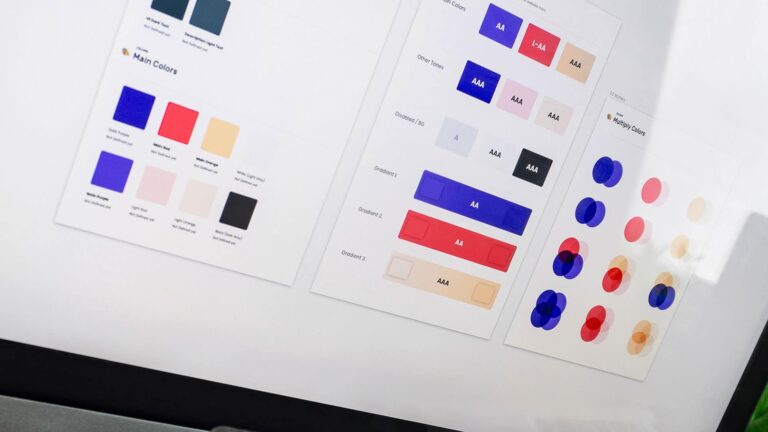
Simple yet attractive visuals
Contents
Considering the amount of time we spend staring at our screens every day, app design must be easy and fun to use, besides being attractive. Users are always seeking comfortable viewing experiences to avoid eye strain, and apps that pair soothing visuals with easily navigable designs have a better shot at success than others. Simple layouts and natural colors enable users to use the app for a longer time without any discomfort.
Gradients
App design has been dominated by ultra minimalism for a long time. In the past, designers reduced the visual properties of their apps to provide more focus on the functional elements and key content. As a result, all interfaces appeared similar and it didn’t take users too long to get bored. However, app designers began experimenting with various visual styles, and gradients soon substituted flat colors as they add depth to flat layouts, making them more visually appealing. Using bright hues as backgrounds can create a vibrant palette, bringing depth and dimension to your app.
Neumorphism
The past few years have seen buttons and icons become increasingly simplistic, and app designers are using something called ‘neumorphism’ to make them more captivating for users. Neumorphism is basically short for ‘new skeumorphism’ – one of the latest app design trends that use the early 2010s style with a modern twist. Real-life imagery is used with advanced 3D-like graphics to provide a better experience to users. Neumorphism offers a rich dimensional makeover to flat buttons and icons. The simplicity of the flat design remains intact, but there’s an eye-catching realism that makes it appear quite tactile and life-like.
Layering and shadowing techniques for greater depth
Layering and shadowing are two popular techniques through which your app can achieve greater depth. Designers are using bold contrasts and shadows to design elements such as graphics and pictures to achieve visual depth. Layering is another technique where parts of the design elements overlap each other, thereby allowing certain elements to achieve greater depth. The effect can also be augmented by adding shadows to the layers, thereby giving your app a new dimension.
Appealing swiping experience
One of the main reasons people prefer mobiles over desktops is the experience of swiping. Clicking can be simple and quick, but swiping is a lot more fun. As per the latest app design trends, capitalizing on the swiping experience and making it more engaging and appealing can help achieve better results in 2021. Improving the swiping experience on your app can be done in myriad ways, be it by incorporating animations to enhance the experience of turning the page, or streamlining user tasks for better functionality.
AR and VR immersion
Augmented Reality and Virtual Reality have garnered plenty of popularity, especially during the lockdowns, as they offer a getaway from the monotony of staying at home. The immersion trend picked up pace in 2020 and is expected to continue this year. A lot of emphasis on this trend is laid on immersive and interactive experiences that can be availed through your mobile device. Using design elements that are engaging and subtle and making users feel like they are inside the app makes the experience more immersive. Think of creative ways to make your users feel like they are playing an immersive game, thereby enhancing the utility of the app along with the visual experience.
Easy-to-use voice interfaces
Among the quickest-growing trends in 2021 are voice interfaces. According to research, 41% of American adults use voice commands for their regular searches. A lot of businesses in the e-commerce, sports, streaming, and news sectors use voice interfaces to offer a seamless experience to users, and smart systems have significantly changed our digital experiences. Siri, Alexa, Google Assistant, and similar voice assistants have come a long way towards enhancing the user experience. Using speech recognition and enabling your users to interact with your app with certainly boost engagement, and also make it easier for your users to attain information.
Data visualization
Data visualization can be used to get creative with your analytics. If there is data to present on your app, you can communicate it in a fun way through data visualization. Engagement can be improved with the use of different kinds of animations, graphs, and colors to make your data appear more stimulating. As a result, you can provide your users with information in a fun and engaging manner.
Geometric and abstract art
Geometric and abstract art can be advantageous for some brands despite the fact that dimensional effects and realism are the order of the day for app design trends in 2021. Abstract shapes and bright colors have the potential to draw the attention of users without distracting them from the functionality of your app. This latest trend aims to find the perfect balance between simplicity and intricate detail by weaving in subtle artistry. Experimenting with different variations of abstract imagery to achieve an interestingly delicate yet simple design can attract users and keep them on the app for longer.
These app design trends for 2021 aim to make the use of apps more engaging and comfortable. Considering the amount of time we spend on our phones these days, apps have evolved to be more than just tools. They have the potential to become the companions of users and keep them hooked for hours. It is, therefore, crucial to stay up to date with the latest app design trends and implement the right strategies to stay ahead of your competitors. Following these trends can help your app improve in terms of visuals as well as functionality. Through these trends, you can enhance the user experience and improve engagement, and ultimately improving your brand.




![5 Ways to Fix the SSH Connection Refused Error [SOLVED]](https://linuxpunx.com/wp-content/uploads/2024/07/5-ways-to-fix-the-ssh-connection-refused-error-solved-768x514.png)

